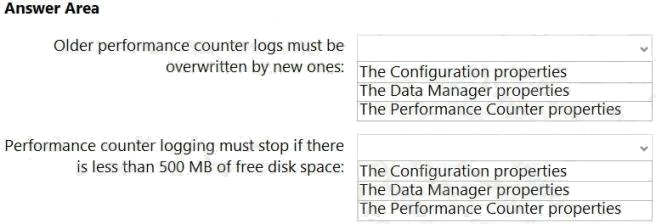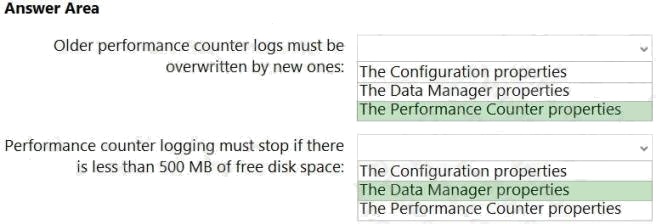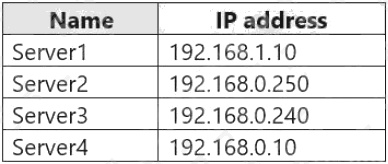microsoft az-801 practice test
Configuring Windows Server Hybrid Advanced Services
Note: Test Case questions are at the end of the exam
Question 1 Topic 6, Mixed Questions
DRAG DROP
You have an Azure virtual machine named VM1 that runs Windows Server. VM1 has boot diagnostics configured to use a
managed storage account.
You are troubleshooting connectivity issue on VM1.
You need to run a PowerShell cmdlet on VM1 by using the Azure Serial Console.
Which four actions should you perform in sequence? To answer, move the appropriate actions from the list of actions to the
answer area and arrange them in the correct order.
Select and Place:
Answer:

Explanation:
Reference:
https://docs.microsoft.com/en-us/troubleshoot/azure/virtual-machines/serial-console-overview https://docs.microsoft.com/en-
us/troubleshoot/azure/virtual-machines/serial-console-windows
Question 2 Topic 6, Mixed Questions
You have a Site-to-Site VPN between an on-premises network and an Azure VPN gateway. BGP is disabled for the Site-to-
Site VPN.
You have an Azure virtual network named Vnet1 that contains a subnet named Subnet1. Subnet1 contains a virtual machine
named Server1.
You can connect to Server1 from the on-premises network.
You extend the address space of Vnet1. You add a subnet named Subnet2 to Vnet1. Subnet2 uses the extended address
space. You deploy an Azure virtual machine named Server2 to Subnet2.
You cannot connect to Server2 from the on-premises network. Server1 can connect to Server2.
You need to ensure that you can connect to Subnet2 from the on-premises network.
What should you do?
- A. Add an additional Site-to-Site VPN between the on-premises network and Vnet1.
- B. Add a private endpoint to Subnet2.
- C. To Subnet2, add a route table that contains a user-defined route.
- D. Update the routing information on the on-premises routers.
Answer:
D
Question 3 Topic 6, Mixed Questions
You have an Azure virtual machine named VM1.
You install an application on VM1, and then restart the virtual machine.
After the restart, you get the following error message: Boot failure. Reboot and Select proper Boot Device or Insert Boot
Media in selected Boot Device. You need to mount the operating system disk offline from VM1 to a temporary virtual
machine to troubleshoot the issue.
Which command should you run in Azure CLI?
- A. az vm repair create
- B. az vm boot-diagnostics enable
- C. az vm capture
- D. az vm disk attach
Answer:
A
Explanation:
Reference:
https://docs.microsoft.com/en-us/cli/azure/vm/repair?view=azure-cli-latest
Question 4 Topic 6, Mixed Questions
HOTSPOT
You have a server named Server1 that runs Windows Server.
On Server1, you create a Data Collector Set named CollectorSet1 based on the Basic template.
You need to configure CollectorSet1 to meet the following requirements:
Older performance counter logs must be overwritten by new ones.
Performance counter logging must stop if there is less than 500 MB of free disk space.
What should you configure for each requirement? To answer, select the appropriate options in the answer area.
NOTE: Each correct selection is worth one point.
Hot Area:
Answer:

Question 5 Topic 6, Mixed Questions
You have five Azure virtual machines.
You need to collect performance data and Windows Event logs from the virtual machines. The data collected must be sent to
an Azure Storage account.
What should you install on the virtual machines?
- A. the Azure Connected Machine agent
- B. the Azure Monitor agent
- C. the Dependency agent
- D. the Telegraf agent
- E. the Azure Diagnostics extension
Answer:
E
Explanation:
Reference: https://docs.microsoft.com/en-us/azure/azure-monitor/agents/diagnostics-extension-overview
Question 6 Topic 6, Mixed Questions
Your on-premises network contains two subnets. The subnets contain servers that run Windows Server as shown in the
following table.
Server4 has the following IP configurations:
Ethernet adapter Ethernet:
Connection-specific DNS Suffix . . :
IPv4 Address . . . . . . . . . . . : 192.168.0.10
Subnet Mask . . . . . . . . . . . : 255.255.255.0
Default Gateway . . . . . . . . . : 192.168.0.1
From Server4, you can ping Server1 and Server2 successfully. When you ping Server3, you get a Request timed out
response.
From Server2, you can ping Server1 and Server3 successfully.
The misconfiguration of which component on Server3 can cause the Request timed out response?
- A. default gateway
- B. IP address
- C. subnet mask
- D. DNS server
Answer:
C
Question 7 Topic 6, Mixed Questions
You plan to deploy the Azure Monitor agent to 100 on-premises servers that run Windows Server.
Which parameters should you provide when you install the agent?
- A. the client ID and the secret of an Azure service principal
- B. the name and the access key of an Azure Storage account
- C. a connection string for an Azure SQL database
- D. the ID and the key of an Azure Log Analytics workspace
Answer:
D
Explanation:
Reference: https://docs.microsoft.com/en-us/windows-server/storage/storage-spaces/configure-azure-monitor
Question 8 Topic 6, Mixed Questions
You have a server named Server1 that runs the Remote Desktop Session Host role service. Server1 has five custom
applications installed.
Users who sign in to Server1 report that the server is slow. Task Manager shows that the average CPU usage on Server1 is
above 90 percent. You suspect that a custom application on Server1 is consuming excessive processor capacity.
You plan to create a Data Collector Set in Performance Monitor to gather performance statistics from Server1.
You need to view the resources used by each of the five applications.
Which object should you add to the Data Collector Set?
- A. Processor information
- B. Processor
- C. Process
- D. Processor performance
Answer:
C
Question 9 Topic 6, Mixed Questions
You have an Azure virtual machine named VM1. Crash dumps for a process named Process1 are enabled for VM1.
When process1.exe on VM1 crashes, a technician must access the memory dump files on the virtual machine. The
technician must be prevented from accessing the virtual machine.
To what should you provide the technician access?
- A. an Azure file share
- B. an Azure Log Analytics workspace
- C. an Azure Blob Storage container
- D. a managed disk
Answer:
C
Explanation:
Reference: https://docs.microsoft.com/en-us/azure/azure-monitor/agents/diagnostics-extension-overview
Question 10 Topic 6, Mixed Questions
You have an Azure virtual machine named VM1 that has the Web Server (IIS) server role installed. VM1 hosts a critical line-
of-business (LOB) application.
After the security team at your company deploys a new security baseline to VM1, users begin reporting that the application is
unresponsive.
You suspect that the security baseline has caused networking issues.
You need to perform a network trace on VM1.
What should you do?
- A. From VM1, run netstat.
- B. From Performance Monitor on VM1, create a Data Collector Set.
- C. From the Azure portal, configure the Diagnostics settings for VM1.
- D. From the Azure portal, configure the Performance diagnostics settings for VM1.
Answer:
D
Explanation:
Reference: https://docs.microsoft.com/en-us/troubleshoot/azure/virtual-machines/performance-diagnostics
Question 11 Topic 6, Mixed Questions
You have an on-premises network and an Azure virtual network.
You establish a Site-to-Site VPN connection from the on-premises network to the Azure virtual network, but the connection
frequently disconnects.
You need to debug the IPsec tunnel from Azure.
Which Azure VPN Gateway diagnostic log should you review?
- A. GatewayDiagnosticLog
- B. RouteDiagnosticLog
- C. IKEDiagnosticLog
- D. TunnelDiagnosticLog
Answer:
D
Explanation:
Reference: https://docs.microsoft.com/en-us/azure/vpn-gateway/troubleshoot-vpn-with-azure-diagnostics
Question 12 Topic 6, Mixed Questions
Note: This question is part of a series of questions that present the same scenario. Each question in the series contains a
unique solution that might meet the stated goals. Some question sets might have more than one correct solution, while
others might not have a correct solution.
After you answer a question in this section, you will NOT be able to return to it. As a result, these questions will not appear in
the review screen.
Your network contains a single-domain Active Directory Domain Services (AD DS) forest named contoso.com. The
functional level of the forest is Windows Server 2012 R2. All domain controllers run Windows Server 2012 R2.
Sysvol replicates by using the File Replication Service (FRS).
You plan to replace the existing domain controllers with new domain controllers that will run Windows Server 2022.
You need to ensure that you can add the first domain controller that runs Windows Server 2022.
Solution: You run the Active Directory Migration Tool (ADMT).
Does this meet the goal?
- A. Yes
- B. No
Answer:
B
Question 13 Topic 6, Mixed Questions
Note: This question is part of a series of questions that present the same scenario. Each question in the series contains a
unique solution that might meet the stated goals. Some question sets might have more than one correct solution, while
others might not have a correct solution.
After you answer a question in this section, you will NOT be able to return to it. As a result, these questions will not appear in
the review screen.
Your network contains a single-domain Active Directory Domain Services (AD DS) forest named contoso.com. The
functional level of the forest is Windows Server 2012 R2. All domain controllers run Windows Server 2012 R2.
Sysvol replicates by using the File Replication Service (FRS).
You plan to replace the existing domain controllers with new domain controllers that will run Windows Server 2022.
You need to ensure that you can add the first domain controller that runs Windows Server 2022.
Solution: You upgrade the PDC emulator.
Does this meet the goal?
- A. Yes
- B. No
Answer:
B
Question 14 Topic 6, Mixed Questions
Note: This question is part of a series of questions that present the same scenario. Each question in the series contains a
unique solution that might meet the stated goals. Some question sets might have more than one correct solution, while
others might not have a correct solution.
After you answer a question in this section, you will NOT be able to return to it. As a result, these questions will not appear in
the review screen.
Your network contains a single-domain Active Directory Domain Services (AD DS) forest named contoso.com. The
functional level of the forest is Windows Server 2012 R2. All domain controllers run Windows Server 2012 R2.
Sysvol replicates by using the File Replication Service (FRS).
You plan to replace the existing domain controllers with new domain controllers that will run Windows Server 2022.
You need to ensure that you can add the first domain controller that runs Windows Server 2022.
Solution: You migrate sysvol from FRS to Distributed File System (DFS) Replication.
Does this meet the goal?
- A. Yes
- B. No
Answer:
A
Explanation:
Reference:
https://www.rebeladmin.com/2021/09/step-by-step-guide-active-directory-migration-from-windows-server-2008-r2-to-
windows-server-2022/
Question 15 Topic 6, Mixed Questions
You have two servers that run Windows Server as shown in the following table.
You need to copy the contents of volume E from Server1 to Server2. The solution must meet the following requirements:
Ensure that files in-use are copied. Minimize administrative effort.

What should you use?
- A. Storage Migration Service
- B. Azure File Sync
- C. Azure Backup
- D. Storage Replica
Answer:
A